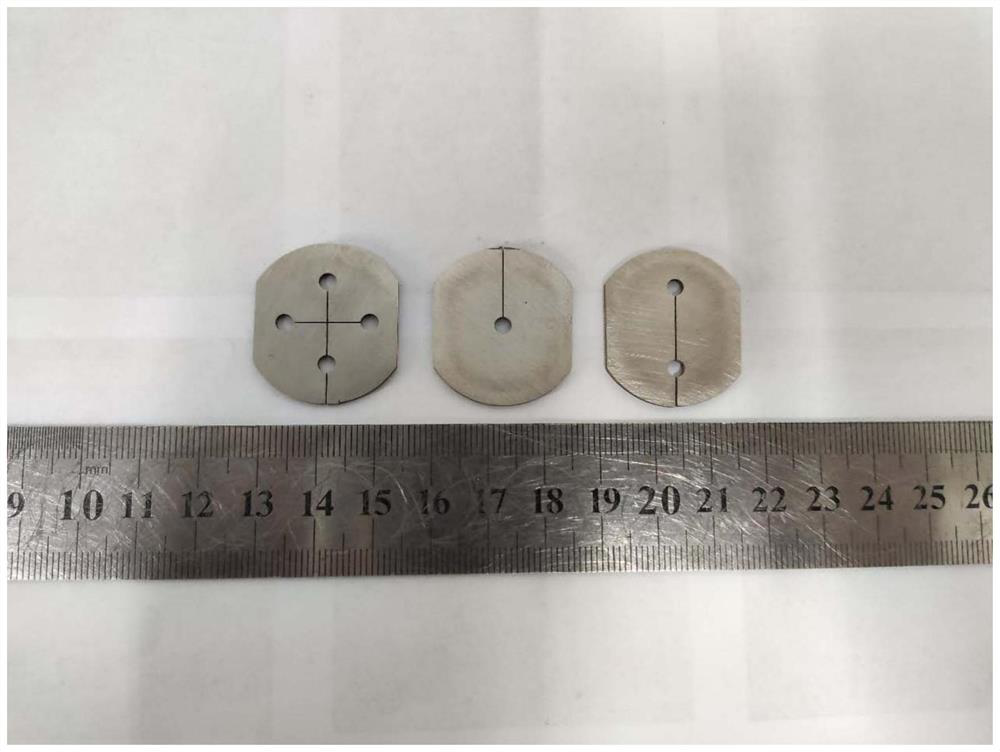Sintering forming method of steel sample with impurities implanted manually
An inclusion and artificial technology, which is applied in the field of sintering and forming of steel samples with artificially implanted inclusions, can solve the problems of inability to accurately locate inclusions, the combination of inclusions and metals, and the influence of accuracy, so as to simplify the sample preparation operation. Difficulty, improve preparation efficiency, improve the effect of precision and reliability
- Summary
- Abstract
- Description
- Claims
- Application Information
AI Technical Summary
Problems solved by technology
Method used
Image
Examples
Embodiment 1
[0037] This embodiment provides a sintering forming method of a steel sample artificially implanted with inclusions:
[0038] Among them, the steel sample is a 304 stainless steel cylinder sample with a diameter of 10 mm and a height of 15 mm. Artificially implanted inclusions are Al 2 o 3 , which is a cube with side length 2 mm. The Al 2 o 3 The preset implantation position of the inclusion is the center of the 304 stainless steel cylinder sample.
[0039] The specific implementation process is as follows, such as figure 1 with figure 2 Shown:
[0040] 1. Select the appropriate graphite mold and indenter according to the specific size of the stainless steel cylindrical sample to be prepared, and prepare the graphite paper used for demoulding the metal sample;
[0041] 2. Cut the graphite paper 4 to a suitable size and cover it on the inner wall of the graphite mold. The purpose of this is to make the metal sample demould smoothly after the sintering is completed;
...
Embodiment 2
[0053] This embodiment provides a sintering forming method of a steel sample artificially implanted with inclusions:
[0054] Among them, the steel sample is a 304 stainless steel cylinder sample with a diameter of 30 mm and a height of 26 mm. Artificially implanted inclusions are Al 2 o 3 , which is a sphere with a diameter of 2 mm. In this embodiment, a total of four spherical inclusions were implanted, which were respectively distributed in the circumferential direction of the stainless steel sample at a distance of 7.5 mm from the center of the circle.
[0055] The specific implementation process is as follows:
[0056] 1. Select the appropriate graphite mold and indenter according to the specific size of the stainless steel cylindrical sample to be prepared, and prepare the graphite paper used for demoulding the metal sample;
[0057] 2. Cut the graphite paper 4 into a suitable size and cover it on the inner wall of the graphite mold. The purpose of this is to make th...
Embodiment 3
[0071] This embodiment provides a sintering forming method of a steel sample artificially implanted with inclusions:
[0072] Among them, the steel sample is a 304 stainless steel cylinder sample with a diameter of 30 mm and a height of 26 mm. Artificially implanted inclusions are Al 2 o 3 , which is a sphere with a diameter of 2 mm. In this embodiment, a total of two spherical inclusions were implanted, which were respectively distributed in the circumferential direction of the stainless steel sample at a distance of 7.5 mm from the center of the circle.
[0073] The specific implementation process is as follows:
[0074] 1. Select the appropriate graphite mold and indenter according to the specific size of the stainless steel cylindrical sample to be prepared, and prepare the graphite paper used for demoulding the metal sample;
[0075] 2. Cut the graphite paper 4 into a suitable size and cover it on the inner wall of the graphite mold. The purpose of this is to make the...
PUM
 Login to View More
Login to View More Abstract
Description
Claims
Application Information
 Login to View More
Login to View More - R&D Engineer
- R&D Manager
- IP Professional
- Industry Leading Data Capabilities
- Powerful AI technology
- Patent DNA Extraction
Browse by: Latest US Patents, China's latest patents, Technical Efficacy Thesaurus, Application Domain, Technology Topic, Popular Technical Reports.
© 2024 PatSnap. All rights reserved.Legal|Privacy policy|Modern Slavery Act Transparency Statement|Sitemap|About US| Contact US: help@patsnap.com










